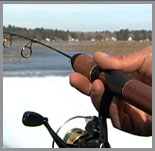
KEEP YOUR TIP-UP LINE SPOOLED TIGHTLY AND EVENLY. This might seem insignificant, but I’ve been surprised how often anglers have their tip-up line spooled loosely and unevenly on their tip-ups—something I never allow to happen with my own gear, because this may cause several undesired results. Even when using liquid-smooth, premium quality tip-ups such as HT’s Polar, Polar Therm or Polar Therm Extreme that consistently deliver high performance cold weather operation, proper line arrangement is a critical factor in a consistently successful tip-up presentation, and this consists of tightly spooled wraps, evenly layered from the innermost band to the outermost one.
When tip-up line is loosely spooled, especially toward the arbor or center of the spool, the outer wraps may cut down into the lower layers, causing tangles. Uneven layers may slip and form loops that can tangle around the line guide, spool handle–even the tube assembly itself.
Needless to say, this may cause lost fish, and on a seemingly less important scale, even the smallest tangles are uncomfortable to try unraveling with wet, cold fingers. Now make that line wet from use–or worse yet, saturated from being submerged in water—and given even moderately cold, windy winter conditions, these layers of wrapped line can freeze tightly together. If the line is loose enough and provides a base for water to thicken around the line, the entire spool may freeze solid, rendering your tip-up useless until the line can be thawed back out.
Even if you’re patient, peel all the layers of frozen line free, then re-spool and tighten the wraps on location, you’re taking a risk. Should you leave any icy line inside the spool, this may re-freeze, and if a hard running fish spins the line down to the frozen spot, this will compromise your chance of success when the fish encounters resistance.
Even if you’re able to strip the line all the way down through the frozen layers and carefully slide it through your fingers to shed water and ice, it’s inevitable some sticky grains will remain adhered to the line or its surface, at least in places. When this ice-coated line is wrapped back onto the spool and consequently returned to the water, the ice will melt away, in effect reducing the line diameter and creating loops or loosely wrapped layers that may again cause tangling.
Worst of all, loose, tangled or jammed line wraps not only create resistance biting fish will feel, but this situation may also create a “backlash” effect, where a lower layer of line may loop or wrap over an outer one, preventing the line from releasing off the spool. Fish that don’t hook themselves will likely drop the bait.
Fortunately, the above problems are easily preventable. First, use a premium, water resistant braided tip-up line, such as HT’s Polar Ice. Tie the line to the arbor, and in the comfort of a warm room, tightly and evenly wrap the fresh, dry line, layer upon layer, until the spool is filled to the desired level, then add your leader, rig, and secure the unit for transit.
Following these guidelines, you can fish your tip-ups confidently, knowing your line will be delivered to biting fish in a continually fluid, smooth motion, minimizing the chance of biting fish feeling anything unnatural, thereby maximizing your chances for success.
Tom Gruenwald works full-time for renowned ice tackle manufacturer HT Enterprises, and has been an avid ice fishing promoter for over 20 years. Tom has written hundreds of ice fishing related articles, published 4 books on the sport of ice fishing, and appears regularly on a variety of popular televised ice fishing shows, including The In-Fisherman Ice Guide, Real Outdoors and Outdoors with Tom Gruenwald, his own endeavor distributed exclusively here at WWW.ICEFISH.COM.

